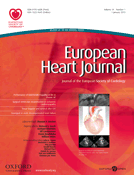EHJ:铁调素水平降低与慢性心衰的不利结果独立显著相关
2013-03-25 coffeecoffee 丁香园
目前,研究人员对心力衰竭病程中铁状态的变化以及心衰的深层病理机制知之甚少。铁代谢的一种主要调节蛋白——铁调素(Hepcidin),可能对该过程起决定作用。因此,波兰弗洛茨瓦夫医科大学的Ewa A. Jankowska等人对收缩性心力衰竭患者体内的铁状态进行了研究,以确定患者体内铁状态随疾病进展的变化,并与远期预后相联系。研究发现,铁调素水平降低与心衰的不利结果独立显著相关,研究结果于2012年11
目前,研究人员对心力衰竭病程中铁状态的变化以及心衰的深层病理机制知之甚少。铁代谢的一种主要调节蛋白——铁调素(Hepcidin),可能对该过程起决定作用。因此,波兰弗洛茨瓦夫医科大学的Ewa A. Jankowska等人对收缩性心力衰竭患者体内的铁状态进行了研究,以确定患者体内铁状态随疾病进展的变化,并与远期预后相联系。研究发现,铁调素水平降低与心衰的不利结果独立显著相关,研究结果于2012年11月23日在线发表于《欧洲心脏杂志》。
研究人员以血清铁蛋白、转铁蛋白饱和度(Tsat)、可溶性转铁蛋白受体(sTfR)和铁调素作为生物标志物,检测了321例慢性收缩性心力衰竭患者和66例性别年龄匹配的健康受试者体内铁状态。受试患者来自三级心脏病学中心,年龄61 ± 11周岁,84%为男性,左心室射血分数31 ± 9%,纽约心脏协会(NYHA)分级:72/144/87/18。
研究结果显示:无症状心衰患者血液状态与健康受试者相近,但铁储备较高(血清铁蛋白水平较高,无显著炎症, P < 0.01),血清铁调素水平也显著提高( P < 0.001)。随着心衰程度的加重,NYHA分级晚期的患者患有铁缺乏症(ID)(血清铁蛋白减少,低Tsat,高sTfR)、铁限制性红细胞生成(血红蛋白数目和红细胞体积分布宽度降低)和炎症(血清高敏C反应蛋白和白介素6水平升高),同时伴有血液循环中铁调素水平的降低(均P < 0.001)。根据多因素Cox模型,铁调素水平降低与3年内心衰患者死亡率升高具有独立显著相关性(P < 0.001)。
该研究表明,心衰早期阶段以循环铁调素水平升高为特征,不伴有贫血或炎症。而心衰病程进展与循环铁调素水平的降低和铁缺乏症有关。低水平的铁调素与心衰的不良后果独立显著相关。
与心衰相关的拓展阅读:

Abstract
Aims The changes in iron status occurring during the course of heart failure (HF) and the underlying pathomechanisms are largely unknown. Hepcidin, the major regulatory protein for iron metabolism, may play a causative role. We investigated iron status in a broad spectrum of patients with systolic HF in order to determine the changes in iron status in parallel with disease progression, and to associate iron status with long-term prognosis. Methods and results Serum concentrations of ferritin, transferrin saturation (Tsat), soluble transferrin receptor (sTfR), and hepcidin were assessed as the biomarkers of iron status in 321 patients with chronic systolic HF [age: 61 ± 11 years, men: 84%, left ventricular ejection fraction: 31 ± 9%, New York Heart Association (NYHA) class: 72/144/87/18] at a tertiary cardiology centre and 66 age- and gender-matched healthy subjects. Compared with healthy subjects, asymptomatic HF patients had similar haematological status, but increased iron stores (evidenced by higher serum ferritin without distinct inflammation, P < 0.01) with markedly elevated serum hepcidin (P < 0.001). With increasing HF severity, patients in advanced NYHA classes had iron deficiency (ID) (reduced serum ferritin, low Tsat, high sTfR), iron-restricted erythropoiesis (reduced haemoglobin, high red cell distribution width), and inflammation (high serum high-sensitivity-C-reactive protein and interleukin 6), which was accompanied by decreased circulating hepcidin (all P < 0.001). In multivariable Cox models, low hepcidin was independently associated with increased 3-year mortality among HF patients (P < 0.001). Conclusions Increased level of circulating hepcidin characterizes an early stage of HF, and is not accompanied by either anaemia or inflammation. The progression of HF is associated with the decline in circulating hepcidin and the development of ID. Low hepcidin independently relates to unfavourable outcome.
小提示:本篇资讯需要登录阅读,点击跳转登录
版权声明:
本网站所有内容来源注明为“梅斯医学”或“MedSci原创”的文字、图片和音视频资料,版权均属于梅斯医学所有。非经授权,任何媒体、网站或个人不得转载,授权转载时须注明来源为“梅斯医学”。其它来源的文章系转载文章,或“梅斯号”自媒体发布的文章,仅系出于传递更多信息之目的,本站仅负责审核内容合规,其内容不代表本站立场,本站不负责内容的准确性和版权。如果存在侵权、或不希望被转载的媒体或个人可与我们联系,我们将立即进行删除处理。
在此留言
本网站所有内容来源注明为“梅斯医学”或“MedSci原创”的文字、图片和音视频资料,版权均属于梅斯医学所有。非经授权,任何媒体、网站或个人不得转载,授权转载时须注明来源为“梅斯医学”。其它来源的文章系转载文章,或“梅斯号”自媒体发布的文章,仅系出于传递更多信息之目的,本站仅负责审核内容合规,其内容不代表本站立场,本站不负责内容的准确性和版权。如果存在侵权、或不希望被转载的媒体或个人可与我们联系,我们将立即进行删除处理。
在此留言








#铁调素#
55